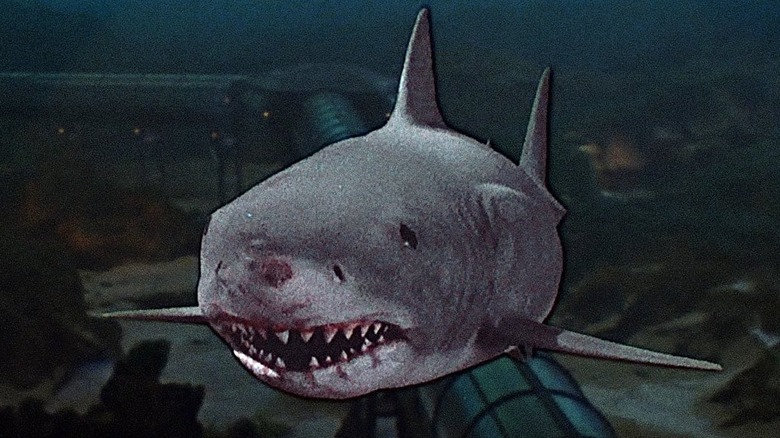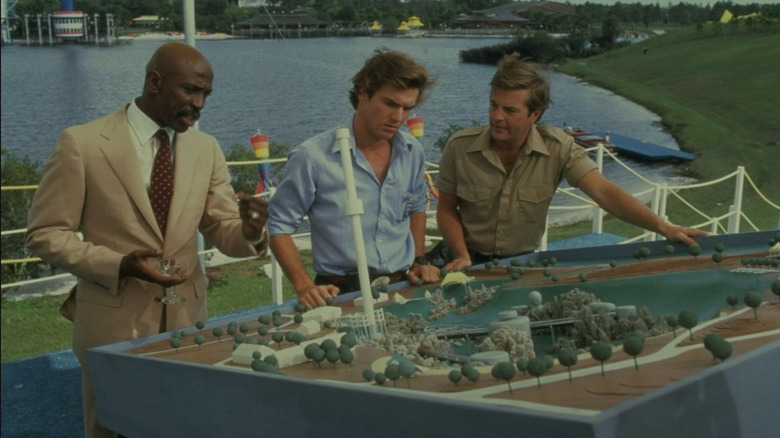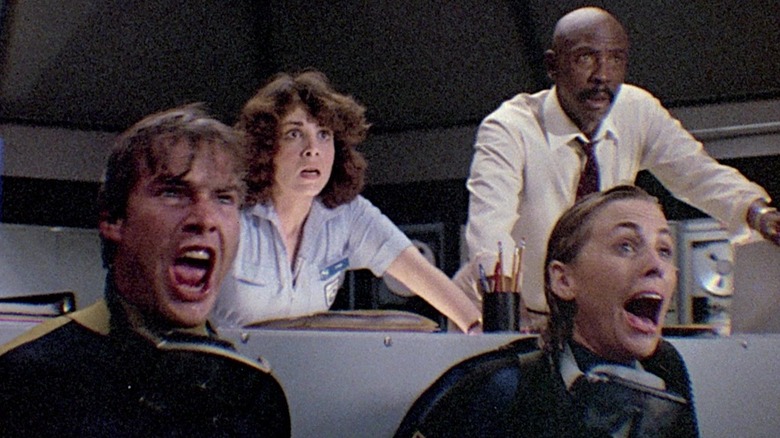Steven Spielberg's Jaws Almost Got A Comedic Sequel That Sounds Amazing
How do you follow up a genre-defining, career-making, massively successful cinematic watershed motion picture like "Jaws?" The answer, apparently, is to make a string of sequels that succumb to increasingly diminished returns. While "Jaws 2" is a highly decent yet nowhere near as stellar follow-up that provided essentially more of the same thrills as the original (which is celebrating its 50th anniversary this month), "Jaws 3" is rightfully regarded as a massive let-down (and the less said about the embarrassment that is "Jaws: The Revenge," the better). Yes, "Jaws 3" is a generally fun, morally prescient time if you take it as a standalone shark thriller movie, but it's still a sad excuse for a sequel to one of the greatest movies ever made. It also begs another, more pressing question: How in the world did this happen?
The answer to that varies with each sequel, of course, and yet there may be a particular circumstance to blame in the case of "Jaws 3." Despite franchise filmmaking being a relatively new thing for major Hollywood studios in the early 1980s, the same goals applied back then as they do now when it comes to executives looking to sequelize, with risk aversion and trend-chasing chief among them. "Jaws" became such a phenomenon so rapidly that in the time between its release and 1978's first sequel, a half dozen or more imitators, rip-offs, also-rans, and the like hit cinema screens around the world. "More of the same" wasn't going to cut it, in other words; if "Jaws" was to continue as a property, Universal Pictures needed to find a gimmick.
Although the short-lived 3-D revival trend of the early '80s eventually became that gimmick, it turns out that producers Richard Zanuck and David Brown hit upon a much more inventive wild swing of a gimmick before landing on the third dimension. After "Jaws," Universal scored another box office smash of a different sort with "National Lampoon's Animal House" in 1978, and the success of that film (plus its own wave of imitators) inspired Zanuck and Brown to pursue the idea of making the third "Jaws" movie a full-on comedic sequel. And though their plan ended up falling apart, the people the producers involved — including "National Lampoon" guru Matty Simmons, screenwriter John Hughes, and director Joe Dante — might have made one of the most subversive sequels ever, had they gotten their "Jaws" project swimming.
Jaws 3, People 0 would've beaten Jaws spoofs at their own game
During the years between the release of "Jaws" and the making of "Jaws 2," the "animals attack" and shark attack subgenres exploded in popularity, and along with that came a series of films that ranged from genuinely chilling to unintentionally campy. In other words, there's a large tonal gulf between movies like "Grizzly," "Orca," and "Tentacles." And since "Jaws 2" came along when the subgenre had already entered its satiric phase with "Piranha," it seemed like Zanuck and Brown were prepared for an "If you can't beat 'em, join 'em" pitch, which is exactly what Simmons delivered to them almost unconsciously. In 2023's "Sharksploitation" (a documentary about the subgenre of the same name), Simmons recalled the related conversation that suddenly became a pitch meeting:
"I was over at Universal. My next-door neighbors were Dick Zanuck and David Brown. First thing [Brown] said to me was, 'Dick and I would love to make a movie with you guys.' So, out of the blue — I just started kidding around — I just said, 'Jaws 3, People Nothing.' I said, 'Peter Benchley walks out of his house in a bathing suit, jumps into his pool, and disappears. And the next thing we see a fin floating around in the pool.' ... He said, 'I love it, I love it, I'll call you tomorrow. We're going to make this movie.'"
The excitement surrounding Simmons' parodic pitch was no joke, as pre-production was then fast tracked on the heels of the release of "Jaws 2." Simmons approached two of his favorite National Lampoon writers to pen the script: Tod Carroll (who would go on to write "Clean and Sober," as well as a failed "Animal House" TV spinoff series) and John Hughes, who was yet to begin a hugely successful screenwriting career with "National Lampoon's Vacation" and as a director himself. Another man who was then on the cusp of breaking out as a filmmaker was Joe Dante, who was tapped to helm "Jaws 3, People 0" after making "Piranha" for producer Roger Corman, a movie that Steven Spielberg himself appreciated. As Dante recalled:
"Universal was very concerned and annoyed that Roger was putting out his rip-off of 'Jaws' the same year that 'Jaws 2' was coming out, and so, they apparently threatened an injunction. I discovered much later that Spielberg had stepped in ... and said, 'No, you don't get it, this is a spoof, this isn't really a rip-off,' although it is a rip-off. And we basically got away with it, I guess is the phrase. And because of that, I was offered 'Jaws 3, People 0.'"
With sets being built, mechanical sharks being worked on, and actors being cast (including late 1970s/early '80s sex symbol Bo Derek), the "Jaws" spoof sequel was looking increasingly seaworthy ... until, that is, the plug was pulled.
The comedic Jaws sequel could have set a wild precedent for franchises to come
Unfortunately, "Jaws 3, People 0" was too unique and too cheeky of a concept to come true, and it's not entirely clear who put a stop to the film or why. Over the years, some have theorized that Spielberg himself wouldn't allow it to continue, others have claimed Zanuck and Brown had second thoughts about making fun of their own work, and so on. According to Dante, however, the issue may have been as simple as good old-fashioned creative differences:
"The National Lampoon people wanted to make an R-rated comedy, like 'Animal House.' And the more conservative Zanuck and Brown team wanted to make a PG and have it be a wide-release family picture ... I think the project died because they just couldn't agree on what movie they were making. And you can't go into a movie with two entities as powerful as National Lampoon was at that time and Zanuck and Brown and have them fighting constantly through the entire movie. It's just a bad idea, and I think they just pulled the plug."
In his estimation, Simmons was more direct and self-effacing, stating simply, "They had to choose between me and Spielberg, and I suspect they made the right choice." Whatever the reasons may have been, it seemed "Jaws 3, People 0" was perhaps too pure (and too purely silly) for this world. Ironically, the trend it nearly revived — a direct parody of its own genre — was something that would make a comeback in several horror movie franchises to follow. It had precedent, of course: 1948's "Abbott and Costello Meet Frankenstein" sent up the Universal Monsters characters, kicking off a slew of horror parodies starring the titular duo. Future entries in popular horror properties like "Friday the 13th Part VI: Jason Lives," "Freddy's Dead: The Final Nightmare," and "Bride of Chucky" also knowingly leaned more into self-aware humor, and of course "Scream" and its sequels made their own franchise about poking fun at tropes in horror movies.
Still, there's something undeniably special about "Jaws 3, People 0" as a lost film, whether it's simply because of the murderer's row of talent that was involved, the sequels that did follow being no one's favorite, or that title being so deliciously ridiculous. It's also entirely possible that the end product wouldn't have been worth it — /Film's own Jeremy Smith discovered as much when researching his oral history of the film for the May 2018 issue of Backstory magazine. Whatever the case, maybe someday we'll get another "Jaws" movie and it might be illustriously irreverent. For now, at least we have "Shark Attack 3: Megalodon."


